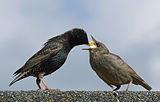- Mucophagy
-
Mucophagy is feeding on mucus of fishes or invertebrates. It may also refer to consumption of mucus or dried mucus in primates.
There are mucophagous parasites, such as some sea lice that attach themselves to gill segments of fish.[1]
Mucophages may serve as cleaners of other animals.
Another usage of this term is in reference to the feeding organ rich in mucous cells which pumps the water through, feeding particles get entrapped in mucus, and the latter proceeds into the esophagus.[2]
See also
References
- ^ Pathogenesis of Wild and Farmed Seafish
- ^ The epibranchial organ, its innervation and its probable functioning in Heterotis niloticus (Pisces, teleostei, osteoglossidae)
Feeding behaviours Carnivores adultHematophagy · Insectivore · Lepidophagy · Man-eater · Molluscivore · Mucophagy · Myrmecophagy · Ophiophagy · Piscivore · Avivore · Spongivore · Vermivore · Herpetivorereproductivecannibalistic
Herbivores Others Methods Apex predator · Bait balls · Bottom feeding · Browsing · Feeding frenzy · Filter feeding · Grazing · Hypercarnivore • Intraguild predation · Kleptoparasitism · Scavenging · TrophallaxisPredation · Antipredator adaptation · Carnivorous plant · Carnivorous fungus · Carnivorous protist · Category:Eating behaviorsCategories:- Carnivory
Wikimedia Foundation. 2010.
